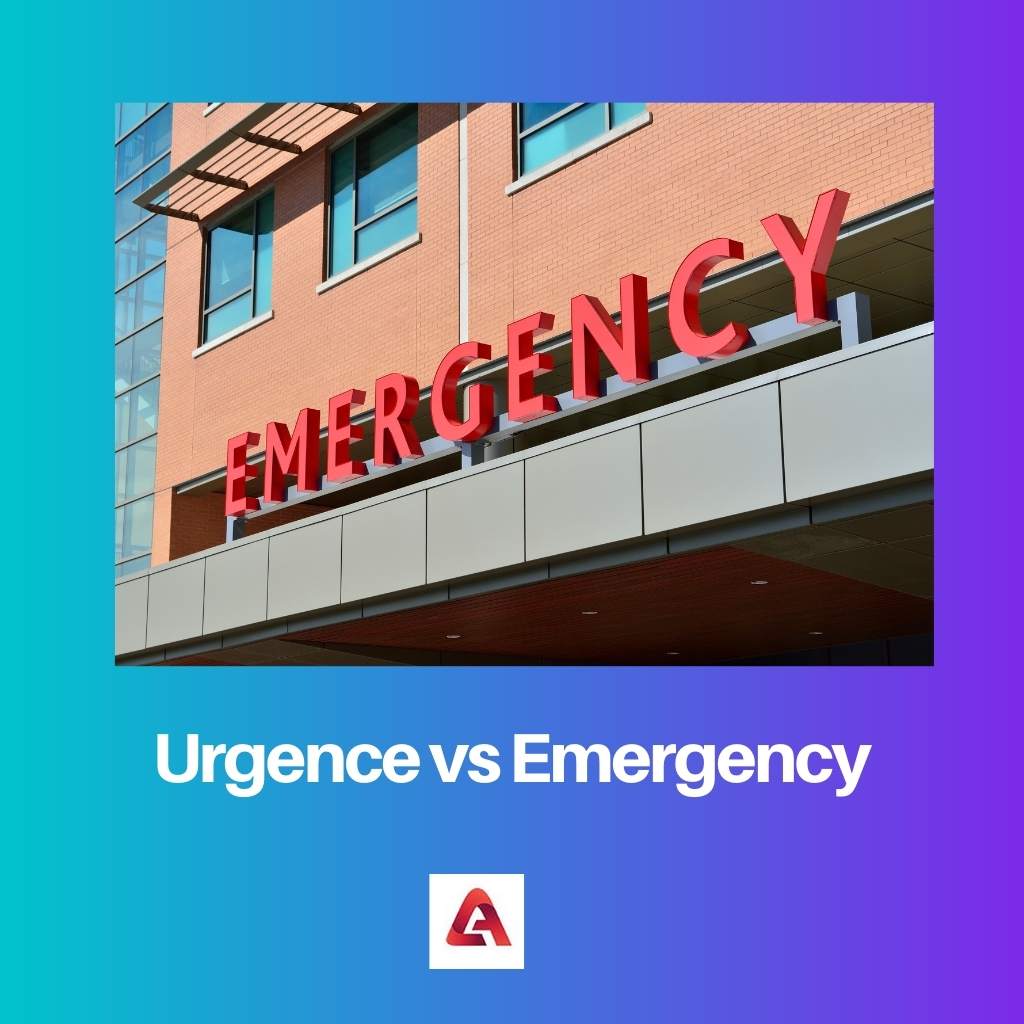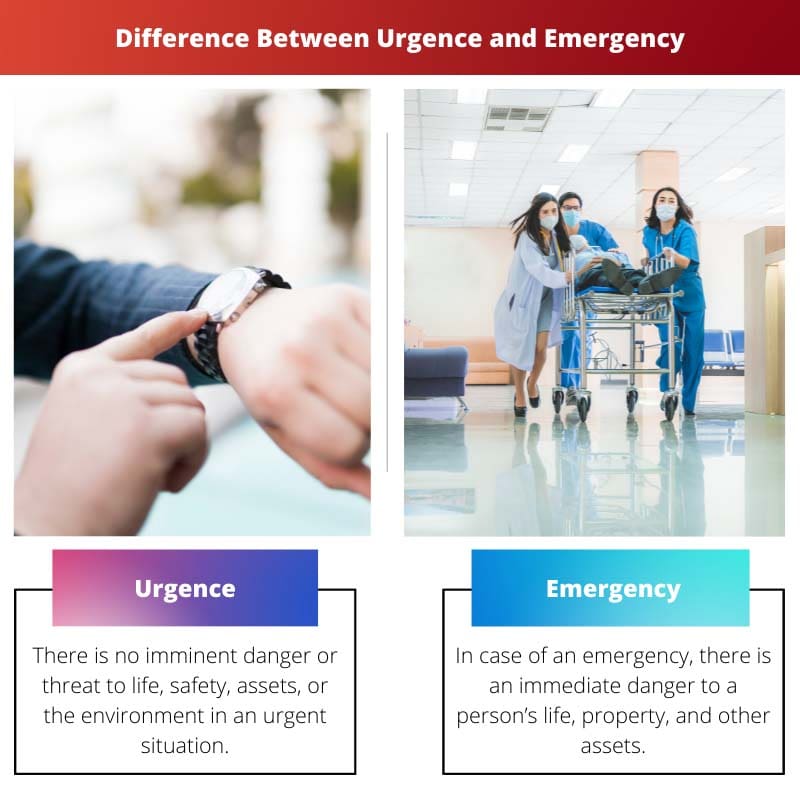Both the terms Urgence and Emergency sound almost the same but are yet pretty different from each other. They both signify different conditions at a particular time.
Most of the time, when we relax, there is no need for these words. Keeping the uncertainty in mind, they both have different significance in life.
Key Takeaways
- Urgence is a French term that translates to urgency in English and refers to a situation that requires prompt attention but is not life-threatening. At the same time, an emergency is a situation that requires immediate action to save life, limb, or property.
- Urgence includes minor injuries, high fever, or moderate pain, while emergencies include heart attacks, severe bleeding, or respiratory distress.
- Urgence can be addressed by primary care providers or urgent care facilities, while emergencies require specialized medical attention in hospitals or emergency departments.
Urgence vs Emergency
Urgency refers to the seriousness of something minor and the need to take immediate action. It could be a fever. Emergency refers to the seriousness of something major that could be life-threatening. For example, heart attacks. In case of emergency, specialized staff is required for treatment.

Urgence refers to a circumstance that requires urgent action, not because one’s life, health, environment, or property is in danger, but because something must be achieved quickly and successfully.
When something is urgent, it must be handled as soon as possible before it gets worse. Urgency guidelines are established by the government and the organizations that are in charge of them.
An emergency is described as a situation in which life, health, property, or the environment are all at risk. In an emergency, immediate action is required to prevent the situation from worsening. In certain cases, the immediate danger cannot be avoided and can only be alleviated by assisting later.
Comparison Table
| Parameters of Comparison | Urgence | Emergency |
|---|---|---|
| Threat to Life | There is no imminent danger or threat to life, safety, assets, or the environment in an urgent situation. Still, if it is not addressed in a reasonable amount of time, the situation can escalate into an emergency. | In case of an emergency, there is an immediate danger to a person’s life, property, and other assets. |
| Parts of Speech | The term urgence signifies an adjective. | Emergency is used as a noun and signifies the same everywhere. |
| Set by Government | According to the rules set by Government, Urgence is used at places when there is no major threat. | Emergency is used in different ways for Pilots, Doctors, and during the management of natural disaster. |
| In medical profession | Non-life threatening illnesses, such as broken limbs, legs, and other minor injuries, are treated at urgent care centres. | A cardiac arrest, profuse bleeding, persistent vomiting, or serious injury are all life-threatening conditions. Expert medical professionals are available in emergency rooms to provide medical assistance in these cases. |
| Advantages | One benefit of going to an urgent care facility is that the doctors are far more acquainted with the people’s clinical background and the procedure is less costly. | The emergency department, on the other hand, sees everyone, regardless of their financial status. |
What is Urgence?
Urgence refers to a situation that requires urgent action, not necessarily because one’s life, health, environment, or assets is in danger, but because something needs to be achieved quickly and successfully.
When something is urgent, it must be handled as soon as possible before it becomes worse. Urgence guidelines are established by the government and the organisations in charge of them. Urgence refers to a threat to one’s health that happens quickly.
It can be defined as a time-sensitive situation. When anything is urgent, it requires immediate intervention, or it will deteriorate. The government and the departments in charge of them have set the criteria for urgency.
Health practitioners, pilots, and other professionals have varying levels of urgency. Health practitioners, pilots, and other practitioners have varying levels of urgency.
The adjective urgent means “needing immediate attention or intervention.” As a result, we use this to explain items that are extremely important and need urgent attention. When anything is urgent, it means we must address it as soon as possible. Besides that, urgent is the adverb type of urgent.

What is Emergency?
An emergency is described as a situation in which life, health, property, or the environment are all at risk.
To avoid worsening the situation in an emergency, immediate action is required. In certain cases, the immediate danger cannot be avoided and can only be alleviated by assisting later.
Getting a heart attack while someone is breaking into your home, seeing an automotive crash, or receiving a life-threatening injury are all real emergencies.
It’s important to note that the concept of “emergency” varies depending on the organization that is in charge of responding to the crisis, the protocols that must be followed, and the authority.
When it falls to a state or territory, the government must define rules and procedures for determining what constitutes an emergency and how to respond to it.
Some disasters, such as natural disasters that endanger several lives at once, are self-evident. No one wants to keep an eye on it or call it an emergency.
Take, for example, the situation in Japan following the tsunami and earthquake. Most accidents, which occur on a smaller scale, necessitate observing anyone and declaring an emergency.

Main Differences Between Urgence and Emergency
- There is no imminent danger or threat to life, safety, assets, or the environment in an urgent situation, but if it is not addressed in a reasonable amount of time, the situation can escalate into an emergency. On the other hand, in case of an emergency, there is an immediate danger to the life of a person, their property, and other assets.
- The term urgency signifies an adjective, whereas Emergency is used as a noun and signifies the same everywhere.
- According to the rules set by Government, Urgence is used at places when there is no major threat. Emergency is used in different ways for Pilots, Doctors, and during the management of natural disasters.
- Non-life-threatening illnesses like broken limbs, legs, and other minor injuries are treated at urgent care centres. On the other hand, cardiac arrest, profuse bleeding, persistent vomiting, or serious injury are all life-threatening conditions. Expert medical professionals are available in emergency rooms to provide medical assistance in these cases.
- One benefit of going to an urgent care facility is that the doctors are far more acquainted with the people’s clinical background, and the procedure is less costly. The emergency department, on the other hand, sees everyone, regardless of their financial status.

- https://www.scielo.br/scielo.php?pid=S1806-83242014000100240&script=sci_arttext
- https://cdn.publisher.gn1.link/reme.org.br/pdf/en_e1308.pdf

Understanding the fine line between Urgence and Emergency is crucial in making decisions. This article breaks down the differences comprehensively.
The article is a great explanation between Urgence and Emergency, as both terms are confused. It’s crucial to understand the difference and know when to apply them in different situations.
This article provides a comprehensive comparison of Urgence and Emergency. Being aware of the disparities is essential as it influences the actions taken during critical situations.
The distinction made in this article is enlightening. Knowing when a situation is an Urgence or an Emergency can be life-saving and should not be overlooked.
The article outlines the differences between Urgence and Emergency articulately. It’s a critical distinction that individuals should be aware of for effective decision-making.
The article delivers an insightful comparison between Urgence and Emergency, providing clarity on when each term applies. It serves as a valuable reference for understanding urgency levels in varying situations.
The article portrays a detailed account of Urgence and Emergency, which is fundamental knowledge. It sheds light on when urgency requires immediate attention and when it escalates to an emergency.
The article effectively articulates the differences between Urgence and Emergency, which is beneficial for everyone to understand and apply in real-life scenarios.
This article provides invaluable insights about these terms. It’s important to recognize the distinction between Urgence and Emergency to handle each situation appropriately.
The contrast between Urgence and Emergency is clear in this article. It’s essential knowledge for everyone to differentiate between the two and make informed choices.